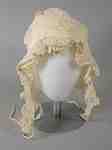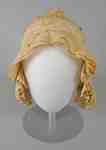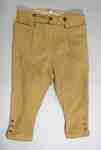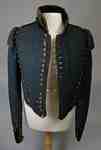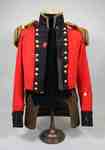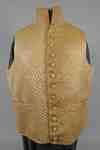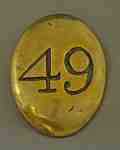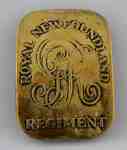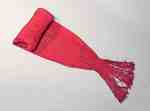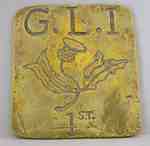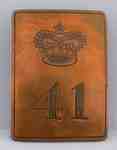Results
We found 170 matching items.




- White Ruffled Bonnet- c. 1810-15
 This bonnet is white with ruffles on the brim and an embroidered panelet crown. The owner is unknown but it is part of the Ball Collection and is dated circa 1810-1815. This bonnet is a good example of the domestic clothing that would have been worn during the time of …
This bonnet is white with ruffles on the brim and an embroidered panelet crown. The owner is unknown but it is part of the Ball Collection and is dated circa 1810-1815. This bonnet is a good example of the domestic clothing that would have been worn during the time of …  This bonnet is white with ruffles on the brim and an embroidered panelet crown. The owner is unknown but it is part of the Ball Collection and is dated circa …
This bonnet is white with ruffles on the brim and an embroidered panelet crown. The owner is unknown but it is part of the Ball Collection and is dated circa … - Black Felt Men's Dress Coat- c.1800
 This is a black felt man's dress coat with wide cuffs and tails, and buttons on the front lapels. The style is from 1790-1800. The coat is believed to have belonged to Reverend Sampson of Grimsby. The coat was donated by the Ball Family and is most likely not Rev. …
This is a black felt man's dress coat with wide cuffs and tails, and buttons on the front lapels. The style is from 1790-1800. The coat is believed to have belonged to Reverend Sampson of Grimsby. The coat was donated by the Ball Family and is most likely not Rev. …  This is a black felt man's dress coat with wide cuffs and tails, and buttons on the front lapels. The style is from 1790-1800. The coat is believed to have …
This is a black felt man's dress coat with wide cuffs and tails, and buttons on the front lapels. The style is from 1790-1800. The coat is believed to have … - Floral Neck Scarf- 1810-1820
 A silk and cotton neck scarf with a lavender, red, pink, blue, green, and black floral print. The motif is predominately on the borders where there is also a fine white silk fringe. This scarf is self-patterned and is dated circa 1810-1820. It provides a good example of domestic clothing …
A silk and cotton neck scarf with a lavender, red, pink, blue, green, and black floral print. The motif is predominately on the borders where there is also a fine white silk fringe. This scarf is self-patterned and is dated circa 1810-1820. It provides a good example of domestic clothing …  A silk and cotton neck scarf with a lavender, red, pink, blue, green, and black floral print. The motif is predominately on the borders where there is also a fine …
A silk and cotton neck scarf with a lavender, red, pink, blue, green, and black floral print. The motif is predominately on the borders where there is also a fine … - Cotton Ruffled Day Bonnet- c.1810-1820
 A day bonnet made of very fine cotton lawn fabric with handworked cotton lace edging and inserts. There are also bands around the cap where the material is gathered in between and lace trim and inset. These caps were indoor caps or lingerie caps and were meant to be worn …
A day bonnet made of very fine cotton lawn fabric with handworked cotton lace edging and inserts. There are also bands around the cap where the material is gathered in between and lace trim and inset. These caps were indoor caps or lingerie caps and were meant to be worn …  A day bonnet made of very fine cotton lawn fabric with handworked cotton lace edging and inserts. There are also bands around the cap where the material is gathered in …
A day bonnet made of very fine cotton lawn fabric with handworked cotton lace edging and inserts. There are also bands around the cap where the material is gathered in … - Breeches Belonging to George Ball- c. 1800
 These breeches belonged to George Ball who was born in Schoharie, N.Y. in 1765, and moved to Upper Canada as a United Empire Loyalist. He served in the War of 1812, was a partner in the establishment of Ball's Mills, and was the original recipient of General Sir Isaac Brock's …
These breeches belonged to George Ball who was born in Schoharie, N.Y. in 1765, and moved to Upper Canada as a United Empire Loyalist. He served in the War of 1812, was a partner in the establishment of Ball's Mills, and was the original recipient of General Sir Isaac Brock's …  These breeches belonged to George Ball who was born in Schoharie, N.Y. in 1765, and moved to Upper Canada as a United Empire Loyalist. He served in the War of …
These breeches belonged to George Ball who was born in Schoharie, N.Y. in 1765, and moved to Upper Canada as a United Empire Loyalist. He served in the War of … - Glengarry Light Infantry Fencibles Junior Officer Coatee Believed to have Belonged to Donald McDougald- 1795-1830

 This is a wool and velvet coatee that is believed to be designed for a Glengarry Militia Officer, but the date of origin is unknown. It is a single breasted green coat with a velvet trimmed stand up collar and cuffs. There are also three rows of buttons down the …
This is a wool and velvet coatee that is believed to be designed for a Glengarry Militia Officer, but the date of origin is unknown. It is a single breasted green coat with a velvet trimmed stand up collar and cuffs. There are also three rows of buttons down the … 
 This is a wool and velvet coatee that is believed to be designed for a Glengarry Militia Officer, but the date of origin is unknown. It is a single breasted …
This is a wool and velvet coatee that is believed to be designed for a Glengarry Militia Officer, but the date of origin is unknown. It is a single breasted … - Uniform Coat Worn by Captain MacMicking of the 1st Regiment of the Lincoln Militia: 1810-1820
 This uniform coat was worn by Captain MacMicking of the Lincoln Militia, 1st Regiment. The double breasted coat is red brushed wool broadcloth with black lace on the dark blue wool lapels, collar and cuffs. There is a stand up collar "Skirt" at the back, one epaulet on the right …
This uniform coat was worn by Captain MacMicking of the Lincoln Militia, 1st Regiment. The double breasted coat is red brushed wool broadcloth with black lace on the dark blue wool lapels, collar and cuffs. There is a stand up collar "Skirt" at the back, one epaulet on the right …  This uniform coat was worn by Captain MacMicking of the Lincoln Militia, 1st Regiment. The double breasted coat is red brushed wool broadcloth with black lace on the dark blue …
This uniform coat was worn by Captain MacMicking of the Lincoln Militia, 1st Regiment. The double breasted coat is red brushed wool broadcloth with black lace on the dark blue … - Uniform Coat Belonging to Colonel Aeneas Shaw of the 1st Regiment of the Lincoln Militia- c.1810-1820

 This uniform coat belonged to Colonel Aeneas Shaw of the 1st Regiment of the Lincoln Militia during the War of 1812. It is believed to be a staff officer uniform and has five pairs of buttons down the front with the “GR” cipher of the British Militia. This wool coat …
This uniform coat belonged to Colonel Aeneas Shaw of the 1st Regiment of the Lincoln Militia during the War of 1812. It is believed to be a staff officer uniform and has five pairs of buttons down the front with the “GR” cipher of the British Militia. This wool coat … 
 This uniform coat belonged to Colonel Aeneas Shaw of the 1st Regiment of the Lincoln Militia during the War of 1812. It is believed to be a staff officer uniform …
This uniform coat belonged to Colonel Aeneas Shaw of the 1st Regiment of the Lincoln Militia during the War of 1812. It is believed to be a staff officer uniform … - Single White Glove- c. 1806-1812
 This single gloves was fashioned from white tulle and carefully embroidered. It is in the long sleeve style and shows what women of 1812 would have worn.
This single gloves was fashioned from white tulle and carefully embroidered. It is in the long sleeve style and shows what women of 1812 would have worn.  This single gloves was fashioned from white tulle and carefully embroidered. It is in the long sleeve style and shows what women of 1812 would have worn.
This single gloves was fashioned from white tulle and carefully embroidered. It is in the long sleeve style and shows what women of 1812 would have worn. - Blue Silk Bodice- c. 1810
 This silk bodice was likely part of an evening dress and may have had a matching skirt. The fabric is from an earlier time period and was most likely remade from an 18th century dress. The bodice features blue and white stitched flowers and gives insight into women's wear in …
This silk bodice was likely part of an evening dress and may have had a matching skirt. The fabric is from an earlier time period and was most likely remade from an 18th century dress. The bodice features blue and white stitched flowers and gives insight into women's wear in …  This silk bodice was likely part of an evening dress and may have had a matching skirt. The fabric is from an earlier time period and was most likely remade …
This silk bodice was likely part of an evening dress and may have had a matching skirt. The fabric is from an earlier time period and was most likely remade … - British Uniform Coatee Worn by Colonel Daniel McDougal- 1812
 This uniform coatee was worn by Colonel Daniel McDougal when he was an Ensign at the Battle of Lundy’s Lane on July 25, 1814. The design is for a Junior officer (ensign or lieutenant) of the Volunteer Incorporated Militia Battalion. It is double breasted with an open stand up collar …
This uniform coatee was worn by Colonel Daniel McDougal when he was an Ensign at the Battle of Lundy’s Lane on July 25, 1814. The design is for a Junior officer (ensign or lieutenant) of the Volunteer Incorporated Militia Battalion. It is double breasted with an open stand up collar …  This uniform coatee was worn by Colonel Daniel McDougal when he was an Ensign at the Battle of Lundy’s Lane on July 25, 1814. The design is for a Junior …
This uniform coatee was worn by Colonel Daniel McDougal when he was an Ensign at the Battle of Lundy’s Lane on July 25, 1814. The design is for a Junior … - Silk and Wool Neck Scarf- c.1800
 This scarf was fashioned out of silk and wool and features a green and rose floral pattern on a cream background and a tassle fringe around the edges. The scarf is thought to have belonged to Mrs. Secord Cartwright.
This scarf was fashioned out of silk and wool and features a green and rose floral pattern on a cream background and a tassle fringe around the edges. The scarf is thought to have belonged to Mrs. Secord Cartwright.  This scarf was fashioned out of silk and wool and features a green and rose floral pattern on a cream background and a tassle fringe around the edges. The scarf …
This scarf was fashioned out of silk and wool and features a green and rose floral pattern on a cream background and a tassle fringe around the edges. The scarf … - British Officer’s Waistcoat Once Belonging to Alonzo Strong
 Part of the Servos Collection, and is listed as a British Officer’s waistcoat once belonging to Alonzo Strong of St. Ann's Ontario. It is more likely that it is a domestic waistcoat. There are eleven self-covered buttons, a cross pattern and quilted in curved lines. Ecru silk waistcoat, chain stitch …
Part of the Servos Collection, and is listed as a British Officer’s waistcoat once belonging to Alonzo Strong of St. Ann's Ontario. It is more likely that it is a domestic waistcoat. There are eleven self-covered buttons, a cross pattern and quilted in curved lines. Ecru silk waistcoat, chain stitch …  Part of the Servos Collection, and is listed as a British Officer’s waistcoat once belonging to Alonzo Strong of St. Ann's Ontario. It is more likely that it is a …
Part of the Servos Collection, and is listed as a British Officer’s waistcoat once belonging to Alonzo Strong of St. Ann's Ontario. It is more likely that it is a … - Cross Belt Plate- 49th Regiment of Foot
 This brass cross belt plate is oval shaped and stamped with a "49". This number symbolizes the 49th Regiment of Foot, the Royal Hertfordshires. The 49th Regiment is perhaps the most well known of those who fought in the War of 1812. The 49th first came to Canada in 1803 …
This brass cross belt plate is oval shaped and stamped with a "49". This number symbolizes the 49th Regiment of Foot, the Royal Hertfordshires. The 49th Regiment is perhaps the most well known of those who fought in the War of 1812. The 49th first came to Canada in 1803 …  This brass cross belt plate is oval shaped and stamped with a "49". This number symbolizes the 49th Regiment of Foot, the Royal Hertfordshires. The 49th Regiment is perhaps the …
This brass cross belt plate is oval shaped and stamped with a "49". This number symbolizes the 49th Regiment of Foot, the Royal Hertfordshires. The 49th Regiment is perhaps the … - Cross Belt Plate- Royal Newfoundland Regiment
 This is an oblong, convex brass plate for a soldier’s cross belt from 1803-1812. It is stamped with the cipher “GR” and “Royal Newfoundland Regiment”. This regiment served in Niagara during the War of 1812 and were present for the attack on Fort George in May 1813. The Royal Newfoundland …
This is an oblong, convex brass plate for a soldier’s cross belt from 1803-1812. It is stamped with the cipher “GR” and “Royal Newfoundland Regiment”. This regiment served in Niagara during the War of 1812 and were present for the attack on Fort George in May 1813. The Royal Newfoundland …  This is an oblong, convex brass plate for a soldier’s cross belt from 1803-1812. It is stamped with the cipher “GR” and “Royal Newfoundland Regiment”. This regiment served in Niagara …
This is an oblong, convex brass plate for a soldier’s cross belt from 1803-1812. It is stamped with the cipher “GR” and “Royal Newfoundland Regiment”. This regiment served in Niagara … - Cross Belt Plate- Regiment de. Watteville
 This rectangular bass plate is stamped with a crown and “GR” cipher with an inscription: “MAIDA” (above crown) and “Reg. de. Watteville” (below cipher). This item is from a cross belt of a uniform of a Regiment of Swiss mercenaries in the British Service, possibly led by Lieutenant Colonel Victor …
This rectangular bass plate is stamped with a crown and “GR” cipher with an inscription: “MAIDA” (above crown) and “Reg. de. Watteville” (below cipher). This item is from a cross belt of a uniform of a Regiment of Swiss mercenaries in the British Service, possibly led by Lieutenant Colonel Victor …  This rectangular bass plate is stamped with a crown and “GR” cipher with an inscription: “MAIDA” (above crown) and “Reg. de. Watteville” (below cipher). This item is from a cross …
This rectangular bass plate is stamped with a crown and “GR” cipher with an inscription: “MAIDA” (above crown) and “Reg. de. Watteville” (below cipher). This item is from a cross … - 18th Century Military Officer's Sash
 This an eighteenth century officer’s woven silk maroon sash with tassels on the ends.
This an eighteenth century officer’s woven silk maroon sash with tassels on the ends.  This an eighteenth century officer’s woven silk maroon sash with tassels on the ends.
This an eighteenth century officer’s woven silk maroon sash with tassels on the ends. - Cross Belt Plate- Glengarry Light Infantry Fencibles
 This brass cross belt plate was fashioned to represent the Glengarry Light Infantry Fencibles. The rectangular plate is stamped with the initials “GLI” and the number one for 1st Battalion. There is also a thistle motif stamped in the centre. Raised in December of 1811, the Glengarry Light Infantry was …
This brass cross belt plate was fashioned to represent the Glengarry Light Infantry Fencibles. The rectangular plate is stamped with the initials “GLI” and the number one for 1st Battalion. There is also a thistle motif stamped in the centre. Raised in December of 1811, the Glengarry Light Infantry was …  This brass cross belt plate was fashioned to represent the Glengarry Light Infantry Fencibles. The rectangular plate is stamped with the initials “GLI” and the number one for 1st Battalion. …
This brass cross belt plate was fashioned to represent the Glengarry Light Infantry Fencibles. The rectangular plate is stamped with the initials “GLI” and the number one for 1st Battalion. … - Cross Belt Plate- 41st Regiment of Foot
 This brass cross belt plate is stamped "41" and a crown which was created to represent the Forty-first Regiment of Foot, also known as the Welsh Regiment.The first battalion came to Canada from Ireland in 1800. Its services were at Detroit, Queenston, Miami, Frenchtown, Fort George, Stoney Creek, Fort Stephenson, …
This brass cross belt plate is stamped "41" and a crown which was created to represent the Forty-first Regiment of Foot, also known as the Welsh Regiment.The first battalion came to Canada from Ireland in 1800. Its services were at Detroit, Queenston, Miami, Frenchtown, Fort George, Stoney Creek, Fort Stephenson, …  This brass cross belt plate is stamped "41" and a crown which was created to represent the Forty-first Regiment of Foot, also known as the Welsh Regiment.The first battalion came …
This brass cross belt plate is stamped "41" and a crown which was created to represent the Forty-first Regiment of Foot, also known as the Welsh Regiment.The first battalion came … - Military Shako Plume

 This plume with black feathers and a wooden base would have been placed on a soldier’s shako. It is believed to have belonged to Captain Martin McLellan who took part in the battle of Queenston Heights and was killed at the battle of Fort George on May 27, 1813. However, …
This plume with black feathers and a wooden base would have been placed on a soldier’s shako. It is believed to have belonged to Captain Martin McLellan who took part in the battle of Queenston Heights and was killed at the battle of Fort George on May 27, 1813. However, … 
 This plume with black feathers and a wooden base would have been placed on a soldier’s shako. It is believed to have belonged to Captain Martin McLellan who took part …
This plume with black feathers and a wooden base would have been placed on a soldier’s shako. It is believed to have belonged to Captain Martin McLellan who took part …

